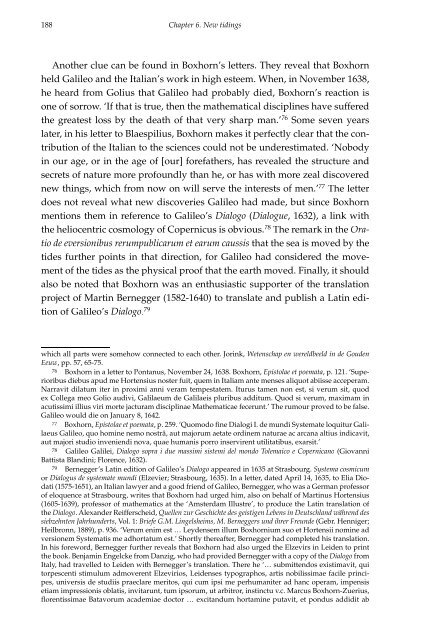historical and political thought in the seventeenth - RePub - Erasmus ...
historical and political thought in the seventeenth - RePub - Erasmus ...
historical and political thought in the seventeenth - RePub - Erasmus ...
Create successful ePaper yourself
Turn your PDF publications into a flip-book with our unique Google optimized e-Paper software.
188<br />
Chapter 6. New tid<strong>in</strong>gs<br />
Ano<strong>the</strong>r clue can be found <strong>in</strong> Boxhorn’s letters. They reveal that Boxhorn<br />
held Galileo <strong>and</strong> <strong>the</strong> Italian’s work <strong>in</strong> high esteem. When, <strong>in</strong> November 1638,<br />
he heard from Golius that Galileo had probably died, Boxhorn’s reaction is<br />
one of sorrow. ‘If that is true, <strong>the</strong>n <strong>the</strong> ma<strong>the</strong>matical discipl<strong>in</strong>es have suffered<br />
<strong>the</strong> greatest loss by <strong>the</strong> death of that very sharp man.’ 76 Some seven years<br />
later, <strong>in</strong> his letter to Blaespilius, Boxhorn makes it perfectly clear that <strong>the</strong> contribution<br />
of <strong>the</strong> Italian to <strong>the</strong> sciences could not be underestimated. ‘Nobody<br />
<strong>in</strong> our age, or <strong>in</strong> <strong>the</strong> age of [our] forefa<strong>the</strong>rs, has revealed <strong>the</strong> structure <strong>and</strong><br />
secrets of nature more profoundly than he, or has with more zeal discovered<br />
new th<strong>in</strong>gs, which from now on will serve <strong>the</strong> <strong>in</strong>terests of men.’ 77 The letter<br />
does not reveal what new discoveries Galileo had made, but s<strong>in</strong>ce Boxhorn<br />
mentions <strong>the</strong>m <strong>in</strong> reference to Galileo’s Dialogo (Dialogue, 1632), a l<strong>in</strong>k with<br />
<strong>the</strong> heliocentric cosmology of Copernicus is obvious. 78 The remark <strong>in</strong> <strong>the</strong> Oratio<br />
de eversionibus rerumpublicarum et earum caussis that <strong>the</strong> sea is moved by <strong>the</strong><br />
tides fur<strong>the</strong>r po<strong>in</strong>ts <strong>in</strong> that direction, for Galileo had considered <strong>the</strong> movement<br />
of <strong>the</strong> tides as <strong>the</strong> physical proof that <strong>the</strong> earth moved. F<strong>in</strong>ally, it should<br />
also be noted that Boxhorn was an enthusiastic supporter of <strong>the</strong> translation<br />
project of Mart<strong>in</strong> Bernegger (1582-1640) to translate <strong>and</strong> publish a Lat<strong>in</strong> edition<br />
of Galileo’s Dialogo. 79<br />
which all parts were somehow connected to each o<strong>the</strong>r. Jor<strong>in</strong>k, Wetenschap en wereldbeeld <strong>in</strong> de Gouden<br />
Eeuw, pp. 57, 65-75.<br />
76 Boxhorn <strong>in</strong> a letter to Pontanus, November 24, 1638. Boxhorn, Epistolae et poemata, p. 121. ‘Superioribus<br />
diebus apud me Hortensius noster fuit, quem <strong>in</strong> Italiam ante menses aliquot abiisse acceperam.<br />
Narravit dilatum iter <strong>in</strong> proximi anni veram tempestatem. Iturus tamen non est, si verum sit, quod<br />
ex Collega meo Golio audivi, Galilaeum de Galilaeis pluribus additum. Quod si verum, maximam <strong>in</strong><br />
acutissimi illius viri morte jacturam discipl<strong>in</strong>ae Ma<strong>the</strong>maticae fecerunt.’ The rumour proved to be false.<br />
Galileo would die on January 8, 1642.<br />
77 Boxhorn, Epistolae et poemata, p. 259. ‘Quomodo f<strong>in</strong>e Dialogi I. de mundi Systemate loquitur Galilaeus<br />
Galileo, quo hom<strong>in</strong>e nemo nostrâ, aut majorum aetate ord<strong>in</strong>em naturae ac arcana altius <strong>in</strong>dicavit,<br />
aut majori studio <strong>in</strong>veniendi nova, quae humanis porro <strong>in</strong>servirent utilitatibus, exarsit.’<br />
78 Galileo Galilei, Dialogo sopra i due massimi sistemi del mondo Tolemaico e Copernicano (Giovanni<br />
Battista Bl<strong>and</strong><strong>in</strong>i; Florence, 1632).<br />
79 Bernegger’s Lat<strong>in</strong> edition of Galileo’s Dialogo appeared <strong>in</strong> 1635 at Strasbourg. Systema cosmicum<br />
or Dialogus de systemate mundi (Elzevier; Strasbourg, 1635). In a letter, dated April 14, 1635, to Elia Diodati<br />
(1575-1651), an Italian lawyer <strong>and</strong> a good friend of Galileo, Bernegger, who was a German professor<br />
of eloquence at Strasbourg, writes that Boxhorn had urged him, also on behalf of Mart<strong>in</strong>us Hortensius<br />
(1605-1639), professor of ma<strong>the</strong>matics at <strong>the</strong> ‘Amsterdam Illustre’, to produce <strong>the</strong> Lat<strong>in</strong> translation of<br />
<strong>the</strong> Dialogo. Alex<strong>and</strong>er Reifferscheid, Quellen zur Geschichte des geistigen Lebens <strong>in</strong> Deutschl<strong>and</strong> während des<br />
siebzehnten Jahrhunderts, Vol. 1: Briefe G.M. L<strong>in</strong>gelsheims, M. Berneggers und ihrer Freunde (Gebr. Henniger;<br />
Heilbronn, 1889), p. 936. ‘Verum enim est … Leydensem illum Boxhornium suo et Hortensii nom<strong>in</strong>e ad<br />
versionem Systematis me adhortatum est.’ Shortly <strong>the</strong>reafter, Bernegger had completed his translation.<br />
In his foreword, Bernegger fur<strong>the</strong>r reveals that Boxhorn had also urged <strong>the</strong> Elzevirs <strong>in</strong> Leiden to pr<strong>in</strong>t<br />
<strong>the</strong> book. Benjam<strong>in</strong> Engelcke from Danzig, who had provided Bernegger with a copy of <strong>the</strong> Dialogo from<br />
Italy, had travelled to Leiden with Bernegger’s translation. There he ‘… submittendos existimavit, qui<br />
torpescenti stimulum admoverent Elzevirios, Leidenses typographos, artis nobilissimae facile pr<strong>in</strong>cipes,<br />
universis de studiis praeclare meritos, qui cum ipsi me perhumaniter ad hanc operam, impensis<br />
etiam impressionis oblatis, <strong>in</strong>vitarunt, tum ipsorum, ut arbitror, <strong>in</strong>st<strong>in</strong>ctu v.c. Marcus Boxhorn-Zuerius,<br />
florentissimae Batavorum academiae doctor … excit<strong>and</strong>um hortam<strong>in</strong>e putavit, et pondus addidit ab

















